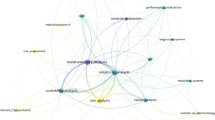Abstract
In this paper, Statistical Activity Cost Analysis (SACA) is used to identify the interaction of mutually dependent physical and financial aspects of a fixed asset-like system configuration. The novelty of the approach is, having established a rational description of the uncertainty inherent in both domains, the analysis of their interaction. Little research to date has investigated the duality of engineering and accounting aspects, in a statistical setting. Our approach is conceptual rather than empirical. We use an illustrative 4-component model, a) to explain the concept of SACA by means of a software demonstration tool, b) to relate financial issues of cost to engineering asset capacity to perform specified tasks, and c) to demonstrate how to produce quantified measures of return and risk, both of which are relevant in areas of life-cycle analysis, budgeting and planning decision-making.
Access this chapter
Tax calculation will be finalised at checkout
Purchases are for personal use only
Similar content being viewed by others
Notes
- 1.
Asset capability is a somewhat general expression and refers to an asset’s ability to perform certain tasks. We use the reliability function to describe engineering asset capability, the physical condition of an asset.
References
Bergerson JA, Lave LB (2005) Should we transport coal, gas, or electricity: cost, efficiency, and environmental implications. Environ Sci Tech 39 (16): 5905–5910
Davis DJ (1952) An analysis of some failure data. J Am Stat Assoc 47 (258): 113–150
Dogramaci A, Fraiman NM (2004) Replacement decisions with maintenance under uncertainty: an imbedded optimal control model. Oper Res 52 (5): 785–794
Engelhardt MO, Skipworth PJ, Savic DA, Saul AJ, Walters GA et al. (2000) Rehabilitation strategies for water distribution networks: a literature review with a UK perspective. Urban Water 2: 153–170
Falta M (2005) Statistical and computational methods to assess uncertainty and risk in accounting. http://adt.caul.edu.au
Falta M, Wolff R (2004) Recent developments of statistical approaches in aspects of accounting: a review. Int Stat Rev 72 (3): 377–396
Gibbins M, Willett RJ (1997) New light on accrual, aggregation and allocation, using an axiomatic analysis of accounting numbers’ fundamental and statistical character. ABACUS 33 (2): 137–167
Hsieh CC (2005) Replacement and standby redundancy policies in a deteriorating system with aging and random shocks. Comput Oper Res 32 (9): 2297–2308
Jiang R, Zhang WJ, Ji P et al. (2003) Required characteristics of statistical distribution models for life cycle cost estimation. Int J Prod Econ 83: 185–194
Kumar UD, Crocker J, Knezevic J, El-Haram M et al. (2000) Reliability, maintenance and logistic support: a life cycle approach. Kluwer Academic Publishers
Lamson ST, Hastings NAJ, Willis RJ et al. (1983) Minimum cost maintenance in heavy haul rail track. J Oper Res Soc 34 (3): 211–223
Monga A, Zuo MJ (2001) Optimal design of series-parallel systems considering maintenance and salvage value. Comput Ind Eng 40: 323–337
Pham H (2003) Software reliability and cost models: perspectives, comparisons, and practice. Eur J Oper Res 149 (3):475–489
Vaurio JK (1995) Optimization of test and maintenance intervals based on risk and cost. Reliab Eng Syst Saf 49 (1): 23–36
Willett RJ (1987) An axiomatic theory of accounting measurement. Account Bus Res 17 (66):155–171
Willett RJ (1988) An axiomatic theory of accounting measurement – part II. Account Bus Res 19 (73): 79–91
Willett RJ (1991) Transaction theory, stochastic processes and derived accounting measurement. ABACUS 27 (2): 117–134
Author information
Authors and Affiliations
Corresponding author
Editor information
Editors and Affiliations
Rights and permissions
Copyright information
© 2010 Springer
About this chapter
Cite this chapter
Colin, A., Falta, M., Su, S., Turner, L., Willett, R., Wolff, R. (2010). A Statistical Activity Cost Analysis of Engineering Assets. In: Amadi-Echendu, J., Brown, K., Willett, R., Mathew, J. (eds) Definitions, Concepts and Scope of Engineering Asset Management. Engineering Asset Management Review, vol 1. Springer, London. https://doi.org/10.1007/978-1-84996-178-3_7
Download citation
DOI: https://doi.org/10.1007/978-1-84996-178-3_7
Publisher Name: Springer, London
Print ISBN: 978-1-84996-177-6
Online ISBN: 978-1-84996-178-3
eBook Packages: EngineeringEngineering (R0)




